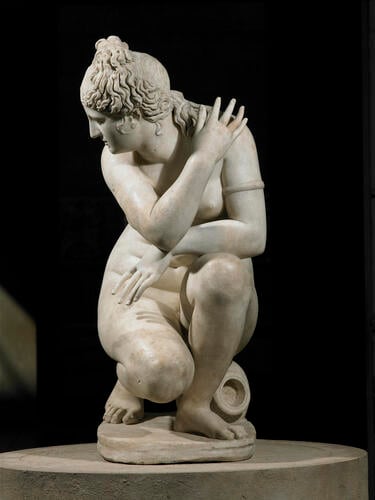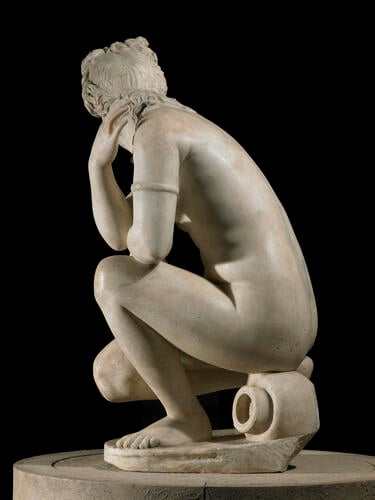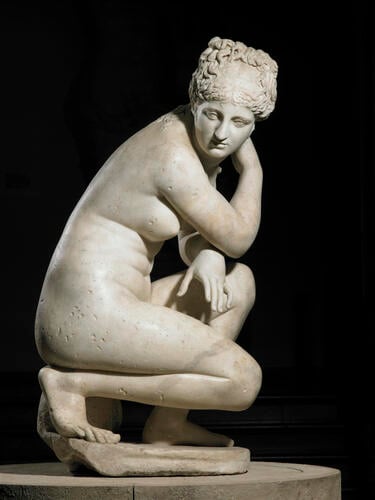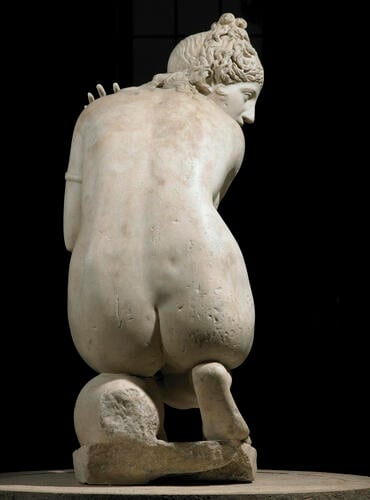-
1 of 253523 objects
Aphrodite or 'Crouching Venus' Second century AD
Marble | 125 x 53 x 65 cm (whole object) | RCIN 69746

Roman Empire
Aphrodite or 'Crouching Venus' Second century AD
Royal Collection Trust/© His Majesty King Charles III 2024. Photograph: British Museum

Roman Empire
Aphrodite or 'Crouching Venus' Second century AD
Royal Collection Trust/© His Majesty King Charles III 2024. Photograph: British Museum




-
A marble statue of Aphrodite, also known as 'Crouching Venus'. This statue is a Roman version of a Hellenistic original of 200 BC. It is carved in marble and shows a female nude, with hair gathered loosely on head and plain strap diadem, crouching with right arm bent across front and left arm resting on left leg; a Hellenistic style armlet is around the upper part of her left arm. On ovoid base.
This marble statue dates from the Antonine period (2nd century AD) and is a Roman version of a Hellenistic original from 200 BC. The original was carved by Praxiteles for a shrine in a temple dedicated to Aphrodite at Knidos in south-west Turkey. It was an important innovation in classical sculpture with the level of articulation in the pose and subsequent models developed further to emphasize the sexuality of the goddess; previously only male figures were depicted nude. The poses showed Aphrodite attempting to cover herself, although the gesticulations tended only to draw attention to her nudity. Some included an urn under her leg to emphasize the fact she was discovered bathing.
There are several antique models of this work, which was described by Pliny in his Natural History (77AD) as being by the hand of the Greek sculptor Doidalsas and displayed in the temple of Jupiter Stator.
The statue may have belonged to Cardinal Alessandro Peretti (1571-1623). It is certainly recorded in the 1631 inventory of statues from the Gonzaga collection in Mantua, where it may have been seen by, and inspired, Peter Paul Rubens who travelled to Italy in 1600. Poses similar to this sculpture can be seen in several of his works including Shivering Venus (Royal Museum of Fine Arts, Antwerp), and after the sculpture was acquired by Charles I in later works also including an adaptation for a nymph in Three Nymphs with a Cornucopia (Dulwich Picture Gallery) and the studies of a crouching nude (University College London) and the very similar pose in Venus Nursing Cupids (private collection Antwerp), as well as several studies in his Theoretical Notebook. The Gonzaga collection was sold by Duke Vincenzo II of Mantua to Charles I. Daniel Nijs, art agent to the English king, described the Crouching Venus as 'the most beautiful sculpture of all' (Nijs to Lord Dorchester, 13 June 1631).
After Charles I's execution the work was sold in the Commonwealth Sale Inventory of 1650 (lot 10, fol. 61v) in the section headed 'statues being hole figures': '88: Sellena hole figure bigger than ye life £600'. It was bought by Robert Houghton and Dividend and subsequently acquired by the artist Peter Lely, earning it another name of the 'Lely Venus'. By 1682 it had returned to the Royal Collection from the artist.
In 1902 it was sent from Kensington Palace to Windsor Castle where it was placed in the Orangery. Since 1963 it has been on long term loan to the British Museum.Provenance
Acquired by Charles I
-
Creator(s)
(nationality)Acquirer(s)
-
Medium and techniques
Marble
Measurements
125 x 53 x 65 cm (whole object)
43 cm (Width) x 58 cm (Depth); 86 cm (Circumference) (at base of object)
600000 g (Weight) (whole object)
Category
Object type(s)